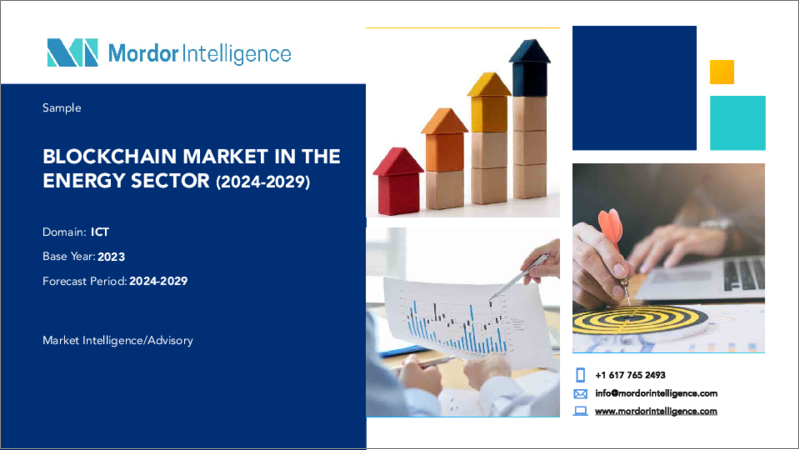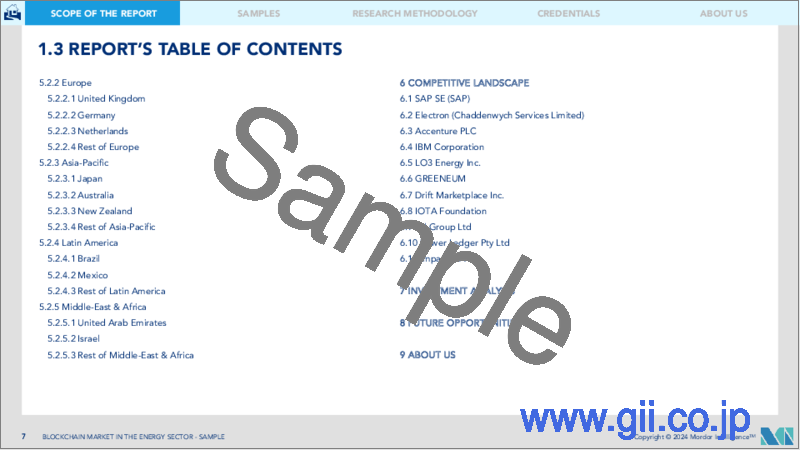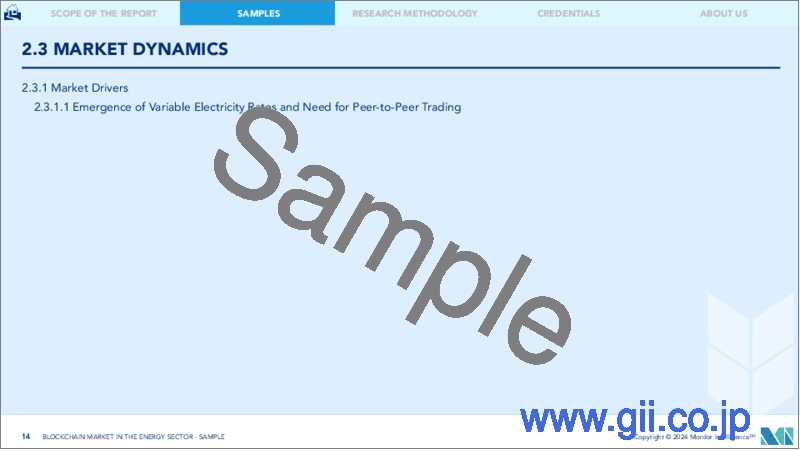|
|
市場調査レポート
商品コード
1190106
エネルギー分野におけるブロックチェーン市場- 成長、動向、予測(2023年~2028年)Blockchain Market In The Energy Sector - Growth, Trends, and Forecasts (2023 - 2028) |
||||||
|
● お客様のご希望に応じて、既存データの加工や未掲載情報(例:国別セグメント)の追加などの対応が可能です。 詳細はお問い合わせください。 |
|||||||
| エネルギー分野におけるブロックチェーン市場- 成長、動向、予測(2023年~2028年) |
|
出版日: 2023年01月18日
発行: Mordor Intelligence
ページ情報: 英文 120 Pages
納期: 2~3営業日
|
- 全表示
- 概要
- 目次
エネルギー分野におけるブロックチェーン市場は、今後5年間で34%のCAGRで推移すると予想されています。
エネルギー部門は、その中央集権的な機能により、高い管理コストや送電コストなど、一定の制約があります。ブロックチェーンはこれらの問題に対処し、単一点故障の範囲を減少させ、サプライチェーン全体の透明性を高めるため、この技術は同分野に大きなデジタル変革をもたらすと期待されています。
主なハイライト
- ブロックチェーン技術は、地域が再生可能エネルギー目標を達成し、送電網の信頼性と効率を向上させ、クリーンエネルギー発電に対する公益事業者の資本支出を削減するのに役立ちます。したがって、予測期間中にその採用が増加することが予想されます。
- マイクログリッドは、指定された地域内で電気の取引を可能にし、緊急時にはメイングリッド(バックアップソリューションとして機能する)と他のそのような利点を持っているので、市場のベンダーは、マイクログリッドの使用の増加を活用することができます。そのような例として、ドイツのエネルギーブロックチェーンベンダーであるOLI Systemsによる欧州のマイクログリッドにおけるパイロットプロジェクトがあります。
- エネルギー分野におけるブロックチェーンの大きなメリットは、コストの削減、環境の持続可能性、プライバシーに妥協することなく利害関係者の透明性を高めることなどが挙げられます。
- 石油・ガスなどのレガシーエネルギー分野も、Enterprise Ethereumソリューションなどのソフトウェアソリューションを導入することで利益を得ることができます。これらの非公開ブロックチェーンネットワークは、事前に承認された関係者にデータの許可と選択的なコンソーシアムアクセスを提供し、石油・ガス会社がプライバシーと企業秘密を保護することを可能にします。
- 重要なアプリケーションの中で、「支払い」カテゴリは、エネルギー分野におけるブロックチェーンの最も高い関連性と実装に似ていました。グリッド材料の保管経路を追跡することで、分散型台帳技術は公益事業者の効率性を向上させる可能性があります。出所追跡を超えて、ブロックチェーンは再生可能エネルギー流通のためのユニークなソリューションを提供します。
- COVID-19のパンデミック危機は、人々の生活、ビジネス、経済に対するデジタル技術とエネルギー技術の役割を拡大させました。この企業は、人々がテレワークを行い、家を暖め、病院を管理し、ビジネスを実行するために、いかにデジタルとエネルギーのソリューションに大きく依存しているかを理解しました。
主な市場動向
ペイメントが市場最大のシェアを占める
- ブロックチェーン台帳は、取引コストの削減、交換の効率化、エネルギーの起源を特定するために、さまざまな分野で利用されています。例えば、IBMのブロックチェーンワールドワイヤーネットワークは、クロスボーダー(外国為替)決済に革命をもたらしました。ほぼリアルタイムの取引清算と最終的な決済を可能にしたのです。この方法は、当事者間で共有される合意された価値の保存場所として機能することで、支払い指示メッセージを統合し、デジタル資産を活用して取引を決済するものです。このような、さまざまな分野での決済を強化する製品の特徴は、市場での競争力を生み出します。
- さらに、ブロックチェーン技術の採用により、決済システムとスマートグリッドの統合が可能になりました。これはさらに、企業が金融サービスをスマートグリッド技術と統合するために、より多くの投資を行うことを支援しました。
- ブロックチェーンは、従来の決済方法を効果的でなくしています。また、ハッキングやデータ漏洩の問題を克服するために進んでいます。例えば、RWEの電力事業者は、ドイツとカリフォルニアにある数百の自律型電気自動車充電ステーションの認証と課金プロセスの管理のためにブロックチェーン技術をテストしています。
- エネルギー分野でブロックチェーンを利用すれば、公益事業者のオーバーヘッドを最小限に抑えることも可能です。中間的な小売業者やブローカーを介さず、電力会社と消費者の間で課金・計測プロセスを円滑化することで、消費者はコスト削減の恩恵を受けることができます。
米国が主要シェアを占める見込み
- エネルギー分野におけるブロックチェーンの採用により、エネルギー取引などの取引をほぼ瞬時に記録・決済することが可能になります。すべての関係者が同じプラットフォームを使用するため、仲介者は不要であり、照合もほとんど必要ありません。技術的な適応が早い北米では、エネルギー分野におけるブロックチェーンが大きく採用されています。
- 米国エネルギー情報局によると、2021年には、米国の公益事業規模の発電施設で約4兆1200億キロワット時(kWh)、つまり約4兆1160億kWhのエネルギーが生産されました。発電に使われる燃料は、石炭、天然ガス、石油、その他のガスが約61%を占めました。また、原子力発電は全体の約19%、再生可能エネルギーは約20%を占めています。また、小規模な太陽光発電システムによる発電量は490億kWhでした。このような大規模なエネルギー生産によって、エネルギー部門はブロックチェーンソリューションを導入し、決済取引、リスクおよびコンプライアンス管理、その他多くの問題を容易にすることができるようになります。
- 政府機関は、エネルギーグリッドの安全性を確保するためにブロックチェーンを取り入れるための資金を付与しています。例えば、国の電力系統の安全確保を支援するために、米国エネルギー省(DOE)はTFA Labsに約20万米ドルの資金を付与しています。提案された戦略では、マルウェアのないグリッド上のデバイスを検証して安全にすること、一般的に使用されている家電製品のセキュリティを高める技術を作ること、ブロックチェーン技術を使って箱から出してすぐにどんなものでも安全にする方法をリーズナブルな価格で提供することが求められています。
- 2022年3月には、持続可能なエネルギーソリューションの開発・所有・運営を行う世界最大の株式非公開企業であるInvenergy社とGE Renewable Energy社が、単一フェーズで建設された北米最大の風力発電所である998メガワットのトラバース風力発電センターの商業運転を発表しています。このような要因が、予測期間中の市場の成長を増大させると予想されます。
競合情勢
エネルギー分野におけるブロックチェーン市場は、競争が激しく、複数の大手企業で構成されています。市場シェアに関しては、現在、SAP SE(SAP)、Microsoft Corp.、Accenture PLC、IBM Corporationなど、少数の主要企業が市場を独占しています。これらの大手企業は、市場シェアの高さを背景に、海外における顧客基盤の拡大に注力しています。これらの企業は、市場シェアと収益性を高めるために、戦略的な協力体制を活用しています。製品能力を強化するために、市場で事業を展開する企業は、エネルギー技術におけるブロックチェーンに取り組む新興企業の買収も行っています。
2021年1月、IBMは、IBM Cloud上のブロックチェーン技術を使用して、Thai Reinsurance Public Company Limited(タイ再保険)が再保険スマートコントラクト生産ネットワークである「Insurer Network」の立ち上げに成功したと発表しました。
2021年5月、 ConsenSys は Microsoft と協業し、ブロックチェーンソリューションの機能を強化しました。決済や金融取引を含むオンラインプレゼンスを拡大する企業が増えており、企業におけるブロックチェーン技術の採用が進んでいます。
2022年7月、INFINITYはブロックチェーン企業Yesportsと提携しました。この提携は、非代替性トークン(NFT)に基づくファンエンゲージメント・プログラムの立ち上げを目指したものです。この取引は、ファンエンゲージメント戦略を確立するためにブロックチェーンとWeb3に頼ろうとするesports組織が増加していることを浮き彫りにしました。
その他の特典です。
- エクセル形式の市場予測(ME)シート
- 3ヶ月間のアナリストサポート
目次
第1章 イントロダクション
- 調査の前提条件条件と市場の定義
- 調査範囲
第2章 調査手法
第3章 エグゼクティブサマリー
第4章 マーケットインサイト
- 市場概要
- 産業の魅力- ポーターのファイブフォース分析
- 供給企業の交渉力
- 消費者の交渉力
- 新規参入業者の脅威
- 競争企業間の敵対関係
- 代替品の脅威
- 産業バリューチェーン分析
- COVID-19が市場に与える影響評価
- 市場促進要因
- 変動する電気料金の出現とピアツーピア取引の必要性
- ベンチャーキャピタルの積極的な資金投入
- 市場抑制要因
- スケーラビリティの制約
- エネルギー分野におけるブロックチェーン- 地域別の使用事例シナリオ
第5章 市場セグメンテーション
- 用途別
- ペイメント
- スマートコントラクト
- デジタルアイデンティティ
- ガバナンス、リスク、コンプライアンス管理
- その他の用途タイプ
- 地域別内訳
- 北米
- 米国
- カナダ
- 欧州
- 英国
- ドイツ
- オランダ
- その他の欧州地域
- アジア太平洋地域
- 日本
- オーストラリア
- ニュージーランド
- その他アジア太平洋地域
- ラテンアメリカ
- ブラジル
- メキシコ
- その他のラテンアメリカ地域
- 中東・アフリカ地域
- アラブ首長国連邦
- イスラエル
- その他中東地域
- 北米
第6章 競合情勢
- 企業プロファイル
- SAP SE(SAP)
- Electron(Chaddenwych Services Limited)
- Accenture PLC
- IBM Corporation
- LO3 Energy Inc.
- GREENEUM
- Drift Marketplace Inc.
- IOTA Foundation
- Btl Group Ltd
- Power Ledger Pty Ltd
- ImpactPPA
第7章 投資分析
第8章 将来的な機会
The Blockchain Market in the Energy Sector is expected to witness a CAGR of 34% over the next five years. Owing to its centralized functioning, the energy sector has certain limitations, including high administration and transmission costs. Since blockchain addresses these issues, decreases the scope for single-point failures, and increases transparency across the supply chain, the technology is expected to bring significant digital transformation to the sector.
Key Highlights
- Blockchain technology helps regions meet renewable energy targets, improve the reliability and efficiency of grids, and reduce utility capital expenditure on clean energy generation. Thus, its adoption is expected to increase over the forecast period.
- As microgrids allow trading electricity within a specified area and have other such benefits during emergencies, with the main grid (acting as backup solutions), vendors in the market could leverage the increasing use of microgrids. One such instance is the pilot project in Europe's microgrid by OLI Systems, an energy blockchain vendor in Germany.
- The significant benefits of blockchain in the energy sector include reduced costs, environmental sustainability, and increased transparency of stakeholders with no compromise on privacy.
- Legacy energy sectors, such as oil and gas, also benefit from implementing software solutions, such as Enterprise Ethereum solutions. These private blockchain networks offer data permission and selective consortium access to pre-approved parties, which enable oil and gas companies to safeguard their privacy and trade secrets.
- Among significant applications, the 'payments' category resembled the highest association and implementation of blockchain in the energy sector. By tracking the chain of custody for grid materials, distributed ledger technology can potentially improve utility providers' efficiencies. Beyond provenance tracking, blockchain offers unique solutions for renewable energy distribution.
- The COVID-19 pandemic crisis magnified the role of digital and energy technologies on people's lives, businesses, and the economy. The business understood how heavily it relied on digital and energy solutions to enable people to telework, heat their homes, manage hospitals, and run their businesses.
Key Market Trends
Payments Hold the Largest Share in the Market
- The blockchain ledger is used across various sectors to reduce transaction costs, increase the efficiency of exchanges, and pinpoint the origins of energy. For instance, IBM's Blockchain World Wire network revolutionized cross-border (Forex) payments. It enabled nearly real-time transaction clearing and settlement with finality. By acting as an agreed-upon store of value shared between parties, the method integrated payment instruction messages and leveraged digital assets to settle transactions. Such product features that enhance payments in different sectors will create a competitive edge in the market.
- Furthermore, the adoption of blockchain technology enabled the integration of payments system with smart grids. This further aided the companies to invest more in integrating financial services with smart grid technology.
- Blockchain has made traditional payment methods less effective. It is also advancing to overcome the issues of hacking and data breaching. For instance, the RWE's power utility has tested blockchain technology to authenticate and manage the billing process for hundreds of autonomous electric-vehicle charging stations in Germany and California.
- Using blockchain in the energy sector would also minimize the overhead for utilities. By facilitating the billing and metering process between the utility and the consumer, instead of involving intermediary retailers and brokers, consumers benefit from lower costs.
United States is Expected to Hold Major Share
- Blockchain adoption in the energy sector allows transactions, such as energy trading, to be recorded and settled almost instantly. Since all parties use the same platform, there is no need for an intermediary and little need for reconciliation. As early technological adaptors, North Americans are witnessing significant adoption of blockchain in the energy sector.
- According to the US Energy Information Administration, in 2021, nearly 4.12 trillion kilowatt-hours (kWh), or about 4,116 billion kWh energy was produced at utility-scale electricity-producing facilities in United States. Coal, natural gas, petroleum, and other gases made up about 61% of the fuel used to generate this power. Nuclear energy roughly accounted for 19% of the total, while renewable energy sources comprised about 20%. Small-scale solar photovoltaic systems generated an additional 49 billion kWh of electricity. Such massive energy production will enable the energy sector to adopt blockchain solutions to ease payment transactions, risk and compliance management, and many such issues.
- Government bodies are granting funds to incorporate blockchain to secure energy grids. For example, to assist in safeguarding the national power system, the US Department of Energy (DOE) is awarding TFA Labs almost USD 200,000 in funding. The suggested strategy calls for verifying and securing devices on the grid that are free of malware, creating technology to increase the security of commonly used consumer electronics, and offering a reasonably priced way to secure any item right out of the box using blockchain technology.
- In March 2022, Invenergy, the largest privately held global developer, owner, and operator of sustainable energy solutions, and GE Renewable Energy announced commercial operations for the 998-megawatt Traverse Wind Energy Center, the largest wind farm constructed in a single phase in North America. Such factors are expected to augment the market's growth during the forecast period.
Competitive Landscape
The blockchain market in the energy sector is highly competitive and consists of several major players. Regarding market share, a few major players currently dominate the market, including SAP SE (SAP), Microsoft Corp., Accenture PLC, and IBM Corporation. With prominent shares in the market, these major players are focusing on expanding their customer base across foreign countries. These companies leverage strategic collaborative initiatives to increase their market shares and profitability. To strengthen their product capabilities, the companies operating in the market are also acquiring start-ups working on blockchain in energy technologies.
In January 2021, IBM announced that using its blockchain technology on IBM Cloud, Thai Reinsurance Public Company Limited (Thai Re) successfully launched "Insurer Network," a reinsurance smart contract production network.
In May 2021, ConsenSys collaborated with Microsoft to strengthen the capabilities of its blockchain solution. With more businesses expanding their online presence to include payments and financial transactions, blockchain technology adoption in the enterprise is growing.
In July 2022, INFINITY partnered with blockchain company Yesports. This partnership aimed to launch a fan-engagement program based on non-fungible tokens (NFTs). The deal highlighted an increasing number of esports organizations looking to rely on blockchain and Web3 to establish fan engagement strategies.
Additional Benefits:
- The market estimate (ME) sheet in Excel format
- 3 months of analyst support
TABLE OF CONTENTS
1 INTRODUCTION
- 1.1 Study Assumptions And Market Definition
- 1.2 Scope Of The Study
2 RESEARCH METHODOLOGY
3 EXECUTIVE SUMMARY
4 MARKET INSIGHTS
- 4.1 Market Overview
- 4.2 Industry Attractiveness - Porter's Five Forces Analysis
- 4.2.1 Bargaining Power of Suppliers
- 4.2.2 Bargaining Power of Consumers
- 4.2.3 Threat of New Entrants
- 4.2.4 Intensity of Competitive Rivalry
- 4.2.5 Threat of Substitutes
- 4.3 Industry Value Chain Analysis
- 4.4 Assessment Of The Impact Of COVID-19 On The Market
- 4.5 Market Drivers
- 4.5.1 Emergence of Variable Electricity Rates and Need for Peer-to-peer Trading
- 4.5.2 Aggressive Spending by Venture Capitalists
- 4.6 Market Restraints
- 4.6.1 Scalability Constraints
- 4.7 Blockchain In Energy Sector - Use Case Scenario Across The Region
5 MARKET SEGMENTATION
- 5.1 By Application
- 5.1.1 Payments
- 5.1.2 Smart Contracts
- 5.1.3 Digital Identities
- 5.1.4 Governance, Risk, and Compliance Management
- 5.1.5 Other Application Types
- 5.2 By Geography
- 5.2.1 North America
- 5.2.1.1 United States
- 5.2.1.2 Canada
- 5.2.2 Europe
- 5.2.2.1 United Kingdom
- 5.2.2.2 Germany
- 5.2.2.3 Netherlands
- 5.2.2.4 Rest of Europe
- 5.2.3 Asia-Pacific
- 5.2.3.1 Japan
- 5.2.3.2 Australia
- 5.2.3.3 New Zealand
- 5.2.3.4 Rest of Asia-Pacific
- 5.2.4 Latin America
- 5.2.4.1 Brazil
- 5.2.4.2 Mexico
- 5.2.4.3 Rest of Latin America
- 5.2.5 Middle East and Africa
- 5.2.5.1 United Arab Emirates
- 5.2.5.2 Israel
- 5.2.5.3 Rest of Middle East and Africa
- 5.2.1 North America
6 COMPETITIVE LANDSCAPE
- 6.1 Company Profiles
- 6.1.1 SAP SE (SAP)
- 6.1.2 Electron (Chaddenwych Services Limited)
- 6.1.3 Accenture PLC
- 6.1.4 IBM Corporation
- 6.1.5 LO3 Energy Inc.
- 6.1.6 GREENEUM
- 6.1.7 Drift Marketplace Inc.
- 6.1.8 IOTA Foundation
- 6.1.9 Btl Group Ltd
- 6.1.10 Power Ledger Pty Ltd
- 6.1.11 ImpactPPA




